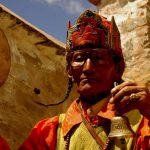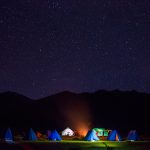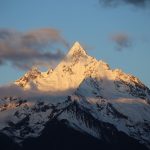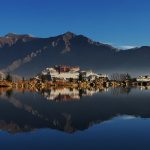Travelling in Tibet
At the best of times travel in Tibet can be awe-inspiring and will push your perception of the world as you thought you knew it. At times it can be downright gruelling. Much of rural Tibet is still very rough and wild and for many this is the greatest attraction of Tibet. We are here to insure that you have the most comfortable trip possible for the places you want to go and the things you want to do. Generally infrastructure has gotten much more efficient and convenient here in the last few years. Road are greatly improved, new hotels have been built (some with heating!) but Tibet still involves a number of special considerations. The standard of service in Tibet cannot be compared to western standards, food is often very different and you will have to adjust your expectations. Below are some of the factors that you should bear in mind before and during your time in Tibet.
Trip selection
Anyone with a reasonable level of fitness can join one of our treks or rafting trips. However, for your own enjoyment, it is important that you read our trek descriptions. We give each of our treks a rating (See: Trip Difficulty Ratings). These indicate the effort and challenge level based on the length of time walking each day, the difficulty of terrain covered and the altitude reached. Please select the grade of trek you feel comfortable with.
Trip Difficulty Ratings All travel in Tibet involves some degree of difficulty. Adjusting to high altitude can be challanging and roads can be rough. To help you choose an itinerary or to help us create an itinerary for you, we have created a grading system that reflects the relative difficulty of the tour.
MODERATE:
Many of our cultural tours fall into this category. The trip is venturesome simply because it is in Tibet, but your tour will not invovle strenuous physical activity. Short walks and stairs will be involved but these tours are suitable for anyone in decent health. Roads can be rough with high altitude passess and accomodation on some nights will not have hot running water.
ADVENTUROUS:
A Reasonably good level of fitness is required. Accomodation often includes camping. The comforts of hotels and restaurants may not be available for extended periods. trekking may not be involved but the stages will not be long and the duration not more than a few days. Long driving days on rough roads over high altitude passes are common and there will be several nights in basic accomodation without running water.
CHALLENGING:
A high level of fitness is required and some pre-trip training should be undertaken. Trekking days may be long on difficult paths at high altitude. Rafting and kayaking may involve long physical days on difficult whitewater. These trips often involve camping for extended periods and the comforts of hotels and restaurants may not be available.
EXPERT:
A specific skill is required such as kayaking or mountaineering. These trips will require working together as a team to meet a difficult goal such as a first descent of a river on an extended kayaking expedition. A high level of physical and psychological stamina is required and prior experience must be discussed with the trip leader.
Getting to Tibet
For better or worse, Tibet is not particularly close to anywhere. There are two standard entry points into Tibet: from Nepal, and from mainland China. We can arrange for transit from either place, either by flight or overland, but we cannot book international flights. You must make your own international flight arrangements, however we can look after all logistics once you arrive in either Nepal or China. (We do book the Kathmandu – Lhasa flight). From China we can arrange for transfers through Beijing, Chengdu, Shanghai, Kunming, and a number of other cities. We can also arrange sightseeing in some major Chinese cities.
Visas and Travel Permits
Tibet is officially a province of China so you need a Chinese visa to enter China and Tibet. (Officially you also need a Tibet entry permit) If you are coming to Tibet through mainland China, you need to apply for your Chinese tourist visa before you arrive. Contact your local nearest Chinese consulate for visa application details. NOTE: When you fill in your application form it is recommended that you do not mention Tibet as some consulates have unclear policy regarding travel to Tibet. Just put down Beijing or Chengdu as your itinerary and write down the hotel you will be staying at as your contact.
IMPORTANT: If you are planning to enter Tibet from Kathmandu DO NOT get your Chinese visa in advance. The Chinese visa is issued as a group visa in Kathmandu and is arranged by Wind Horse along with your Tibet entry permit.
Wind Horse is obliged under Chinese law to arrange Tibet Entry Permit and specific travel permits if your itinerary takes you outside of the Lhasa prefecture. This permit is arrange in advance and will be couriered to your point of entry (usually your hotel). For Wind Horse to arrange permits and visas (if coming through Ktm) we need a digital copy (photo or scan) of you passport info page and your Chinese visa (if coming through mainland China) well in advance. As soon as you commit to your booking, please email your whole groups passports and visas image. (make sure the file is a jpg format readable on your screen but under 200kb please)
Independent Travel to Tibet
Independent travel is currently not allowed in Tibet. This situation may change in the near future but at this stage only groups fully booked in advance (with the correct permits) are allowed into Tibet.
When to go:
Weather
The “normal” tourist season in Tibet is from May through till October. The busiest months are usually July and August. However this is changing as infrastructure deveopment (roads and hotels) makes travelling at other times far easier.
Summer weather can be cool to warm. Summer is the rainy season but it rarely rains for long before the sun comes out. Trekking is possible from April through October. You can trek in winter but it is cold and you should be very experienced.
Fall & Spring are often cool and clear and can be excellent for trekking and cultural trips as you don’t have to face the crowds of Chinese tourists in Lhasa and Shigatse.
Winter is generally cold and clear in Tibet. It is not advised to attempt remote or high journeys during this time without prior experience. However, cultural tours to Lhasa and other regional centers can be very rewarding during winter months as there are hardly any other tourists and it is the customary time for Tibetan pilgrimage to central Buddhist temples. The overland journey from Lhasa to Kathmandu is usually possible year round now that the new road has been built.
Current weather from Tibet
Click for Lhasa, Tibet Forecast
How to book a trip Contact us by email or through our online “Trip Inquiry Form”. Provide us with as much detail as possible about your travel plans. We will respond with a sample itinerary and quote (if it is customized trip). Once we finalise the trip details we forward an invoice by email.
To confirm your trip you must:
* Download Relevant documents from the side bar on this page
* Make a $500/person deposit to secure a reservation
* Email us the bank form as proof of transaction
* You will recieve a reciept from us and invoice for the outstanding balance
* Pay the balance no later than 40 days prior to departure
* Once again we forward receipt for full payment along with detailed trip notes for your trip
* Forward a small but readable jpg format image of your passport information page
* Please ensure you also forward your international flight information which you have booked yourself
We do not make any service confirmations until a deposit is made. We recommend paying well in advance to ensure the best hotel bookings, the best staff available and to ensure external price chances (such as domestic flights etc)
Costs and Pricing
Pricing is general not in this website except for specific trips. This is because our prices vary according to the level of services you request and the exact itinerary you choose. On some trips, group size will also impact on price. PLEASE EMAIL US FOR A QUOTE. Travel here is relatively expensive because most of our itineraries require 4 wheel-drive land-cruisers, special camping equipment, guides and cooks. We service some of the best international adventure travel companies for their Tibet travel and if you compare our prices with those available internationally you will see the obvious value.
Health Considerations
Because of its high altitude, largely remote destinations, and semi-arid weather Tibet comprises a unique set of health concerns. You don’t need to worry about Malaria or odd strains of para-typhoid here, but you should certainly consider the sun and altitude. We do not want to supplant advice from professionals and more complete suggestions available in guidebooks, so we suggest you consult appropriate sources before coming (the CIWEC clinic in Kathmandu provides extensive information that is partially applicable to Tibet). Our trips our designed so you do not over-exert yourself in the first few days, and our guides are experienced and aware of the dangers of altitude sickness. There is preventative and symptomatic medication to help with the minor symptoms of altitude sickness (headaches, nausea) and we recommend that you bring some. We also strongly suggest that you bring sunglasses, hat and sunscreen — Tibet is not the place to work on your tan. Further clothing and equipment depends on the type of trip you are doing here. We are happy to make suggestions (some further notes are included with our “Adventure travel “(B) introduction) or recommend published sources for more information on appropriate supplies.
Travel Insurance
Since we are a registered travel agency in Tibet, you are guaranteed our promised services through the Tibet Tourism Bureau. Unfortunately we are not permitted to offer travel or accident insurance to foreign clients. We urge you to make sure that you are appropriately covered for international travel from an insurer in your home country.
Accommodation & Food
Lhasa is the historical and cultural center of Tibet and also the center for our agency and most practicalities dealing with Tibet. There are comfortable hotels and restaurants and you will be able to access and obtain most modern amenities. As we move farther from Lhasa the commodities, facilities and services will be less available and you will be living more on Tibetan terms. We supply you with the best camping equipment, food, and service facilities that are available here; but please bear in mind this is not a city nor a suburb. Our cooks have several years experience preparing food for foreign clients but are best at preparing Chinese cuisine (adapted for the international palate). Despite the rumors, vegetables of every type and variety are readily available in Lhasa and other major towns so the days of meat and tsampa (roasted barley) are long gone. Our drivers are also the most experienced in Tibet and have driven these roads for years. For itineraries off the main Lhasa-Shigatse-Nepal route landcruisers are needed and we ensure our vehicles are worthy.
Trekking in Tibet
Being physically prepared for your trip is essentail – Take regular exercise, and include some day trips where you walk for the suggested maximum number of hours for your intended trek. Wear the gear that you plan to take, so that you know you will be comfortable in it. In particular, break in any new equipment (boots and pack, for example) before you come. For treks rated Challenging or Expert, we advise that your level of fitness should be high. You should be involved in regular aerobic exercise – for example, swimming, cycling, running, or uphill walking carrying a load on your back. Stamina is a key aspect – both physical and mental. Remember that altitude is a significant factor, and a slow but steady pace is the best way to succeed in the mountains. Even if you are a super-fit athlete, don’t expect to be able to perform as you would at sea level! Please contact us personally if you require further advice about choosing or preparing for your trip.
Rafting in Tibet
From most descriptions of Tibet it is hard to believe that Tibet is home to a large number of spectacular rivers. Mt Kailash, in the west of Tibet is the source of the subcontinent’s four greatest rivers: the Ganges, Indus, Sutlej and Bramaputra. In the east, the forested land of Kham is home to the source of the Mekong and the Yangtse, the 2 largest rivers in East Asia. In the summer months regular rains swell Tibet’s rivers and the result is a surprising number of world class rafting and kayaking rivers.
Tibet Wind Horse Adventure is the only company in Tibet with permits to operate rafting and kayaking trips. We have employed international guides who work along side our Tibetan guides to ensure a very high standard of safety, service and cultural experience. We run a variety of trips that combine some of the striking cultural visits in our general catalogue with rafting and camping in areas of overwhelming beauty. We also have the ability to suggest, guide and handle logistics for first descents by experienced kayakers or rafters.
Kayaking in Tibet
Like anywhere in the world, weather and water levels play a big part in planning river trips in Tibet. Tibet is a huge area and there are many climatic zones so rivers are actually possible year round. BUT…..our rafting rivers (Tolung, Drigung and Reting etc) only run between June and Oct, ie. the wet season. This is the time to paddle any river at high altitude. If you are an adventurous kayaker then East Tibet is home to a multitude of rivers (Parlung, Tong Chu, Yigong, Po etc). These runs can only be paddled during the spring or fall when water levels are low. These runs are very sensitive to water levels. (ie. they get very gnarly when running high!) Some of the more extreme expedition runs out here can only be run in winter. When you book a trip or arrange expedition logistics wiith us we’ll send you a detailed packing list based on the specific trip you are planning.





